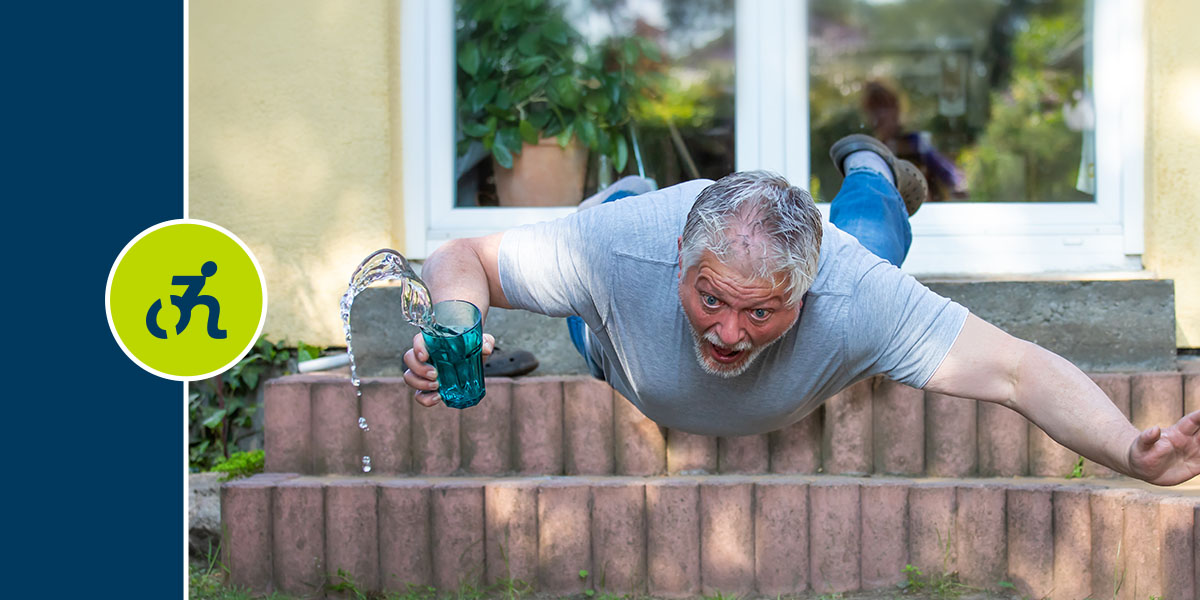
Falls in older adults happen frequently. In the United States, more than 1 in 4 adults over 65 falls annually. While falls are common, you shouldn’t think of them as normal. Although your risk factors generally increase with age, falling isn’t inevitable. Learning what causes the elderly to fall can help you make changes to reduce the risk of falling for yourself or a loved one.
In This Article
- What Causes the Elderly to Fall?
- Why Are Falls So Dangerous for the Elderly?
- Factors Contributing to Falls
- How to Reduce the Risk of Falls
- Explore Ramps From National Ramp
What Causes the Elderly to Fall?
The elderly are more likely to fall than younger people for various reasons, including health changes and environmental conditions. Falling or a fear of falling can also reduce a person’s self-confidence, leading to them staying home more and being less active. Unfortunately, reduced activity then causes muscle weakness and joint stiffness, increasing the risk of falling. Additionally, once someone falls, they are twice as likely to fall again.

Many people experience no symptoms before they fall. However, some signs and symptoms of falls include:
- Dizziness
- Lightheadedness
- Irregular, rapid or pounding heartbeat
When Do Most Falls Occur in the Elderly?
Falls are more likely to happen at night when visibility is poor. Most falls happen indoors while people are moving, such as getting in or out of bed or a chair or going up or down stairs. Rushing or multitasking can increase risk. For example, hurrying to the bathroom in the dark or walking while talking on the phone is more dangerous than walking slowly and paying attention to your surroundings.
Why Are Falls So Dangerous for the Elderly?
Many people injure themselves when they fall. Injuries of all kinds are possible, from mild bruising to severe internal organ damage. Some injuries can be instantly fatal or lead to complications that cause death later. Falling causes nearly all hip fractures and traumatic brain injuries (TBIs). More issues arise if a person falls and cannot get up or summon help.
Factors Contributing to Falls
A person’s physical condition and environment contribute to their risk of falling. Physical conditions likely have a greater effect, but environmental factors can increase these risks even more.
Physical Factors
Several age-related health issues can contribute to an older adult’s risk of falls:
- Muscle weakness: Reduced strength, especially in the legs, can decrease stability and increase the risk of falling.
- Balance and coordination problems: Poor balance and coordination make older adults more vulnerable to falls. Parkinson’s disease, stroke, arthritis and other age-related health concerns can worsen gait and balance issues.
- Decreased vision: People with vision impairments are more likely to fall since they have more difficulty seeing potential hazards such as obstacles or uneven surfaces.
- Decreased hearing: Reduced hearing can make people less aware of their environment and inhibit their ability to respond to auditory cues.
- Numbness or decreased sensation: Older adults with reduced feeling in their feet and legs are more likely to fall since they have more difficulty telling where they are stepping.
- Incontinence: Needing to use the bathroom urgently or frequently can lead to hurrying, putting a person off-balance and increasing the risk of falling.
- Cardiovascular issues: People with heart problems such as high blood pressure and arrhythmia are more likely to become dizzy or lightheaded and fall.

Additionally, any condition that causes dizziness, lightheadedness, fainting or loss of consciousness can lead to a fall, including side effects from certain medications, low vitamin D levels and dehydration.
Environmental Factors
A person’s environment often exacerbates physical conditions, increasing their chances of falling. Here are the most common environmental factors contributing to falls:
- Obstacles: Clutter and other objects on a walkway increase the risk of falling significantly. Common obstacles include shoes, extension cords and items for pets.
- Uneven surfaces: Irregular walking surfaces increase the likelihood of a fall. Loose rugs, poorly maintained floors and changes in flooring often create uneven surfaces inside. Watch for bumpy ground, sidewalk cracks, snow and ice outside.
- Poor lighting: Low lighting reduces visibility and raises fall risk. Poor lighting conditions could be due to an insufficient number of light fixtures or light switches that are difficult or inconvenient to turn on.
- Lack of grab bars and handrails: An absence of grab bars and handrails makes it harder for older adults to catch themselves if they slip or stumble. Improperly installed grab bars and railings can be even more dangerous than not having any at all if someone tries to use them and they aren’t secure.
- Unfamiliar surroundings: Simply being in a new place can also increase the risk of falling.
How to Reduce the Risk of Falls
You can make several changes to address the factors that contribute to falling and reduce the risk:
- Exercise regularly: Regular exercise improves strength, balance and coordination. Consider a low-impact option like tai chi, yoga, swimming or water aerobics. Even just walking can be helpful. For more severe issues, adding specific activities to improve balance or consulting with a physical or occupational therapist may be necessary.
- Visit your doctor: Regular check-ups, including eye and hearing checks, can help keep you healthy. Consider reviewing any medications for side effects such as dizziness, drowsiness or impaired coordination, and discuss alternatives with your physician.
- Move carefully: Get up slowly from sitting or lying down to prevent lightheadedness from standing too quickly. Pay attention when you walk, watching for obstacles or unevenness.
- Wear proper footwear: Ensure you have well-fitting, comfortable shoes with non-slip soles. Loose shoes or slippers, heels and shoes with worn soles all increase the risk of falls.
- Use mobility devices: If necessary, use a cane, walker, wheelchair or scooter. Ensure any mobility device you use is the right size.
- Clear clutter: Keep walkways clear of tripping hazards. Secure loose rugs with carpet tape or a non-slip pad.
- Improve lighting: Ensure adequate lighting inside and out, especially in stairwells. You might just need brighter bulbs. If you have enough lights but turning them on is challenging, upgrade to rocker or motion-activated light switches. Nightlights can increase visibility at night and reduce the fear of falling.
- Install grab bars and handrails: If you don’t have any grab bars or railings — especially in bathrooms and along stairs — install some right away. Check them regularly to ensure they are still appropriately secured.
- Install a ramp: Tall thresholds and porch stairs without railings can be difficult or impossible to navigate with mobility aids. Ramps improve accessibility, allowing older adults to remain independent and in their own homes. Ensure you choose a ramp with a safe slope, adequate traction and handrails.

Explore Ramps From National Ramp
At National Ramp, our purpose is to help people with limited mobility maintain their freedom safely. Our ramps are available in many materials and styles, so you can choose one that coordinates with your home. We keep every option in our inventory, ready to send out the same day we receive orders. Most of our ramp systems can be installed in three days. Whether you need the added traction of solid aluminum, the drainage of mesh or the customizability of wood, rest assured you’ll get a safe, high-quality ramp quickly. If you have any questions, please reach out to us so we can help!
Don’t Risk Injury To You Or A Loved One
Why wait? Give us a call at 877-596-7293 or contact us online to get started!